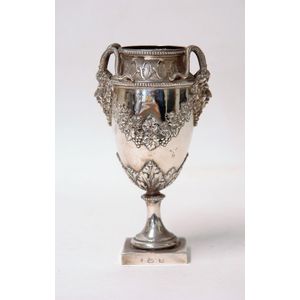Russian Ormolu & Amethyst Cut Glass Vases, 1830-40
You must be a subscriber, and be logged in to view price and dealer details.
Subscribe Now to view actual auction price for this item
When you subscribe, you have the option of setting the currency in which to display prices to $Au, $US, $NZ or Stg.
- Ormolu - Ormolu was popular with French craftsmen in the 18th and 19th century for ornamental fittings for furniture, clocks and other decorative items. True ormolu is gilt bronze, that is bronze that has been coated with gold using a mercury amalgam. Due to the health risks associated with using mercury, this method of creating ormolu was discontinued in France in the 1830s. A substitute was developed consisting of about 75% copper and 25% zinc, however it was inferior to the bronze version. It was often lacquered to prevent it tarnishing.
- Important - Important is a word used in the antique trade to indicate an object should be ranked above other similar objects, and is therefore more valuable.
The object could be considered important because it is by a famous designer or maker, has been shown at a major exhibition, is of exquisite workmanship, is rare or is a "one-off", was made for an important patron, and so on.
Even further up the pecking order are objects that are described in catalogue descriptions as highly important or extraordinarily important. - Circa - A Latin term meaning 'about', often used in the antique trade to give an approximate date for the piece, usually considered to be five years on either side of the circa year. Thus, circa 1900 means the piece was made about 1900, probably between 1895 and 1905. The expression is sometimes abbreviated to c.1900.
- Oviform /ovoid - The outline loosely resembling the shape of an egg.
This item has been included into following indexes:
- Russian
Visually similar items

An impressive pair of bronze and brass urns having Bachanalian scene. 33 cm high.

A Royal Vienna royal blue and cherub decorated gilded handled vase and cover

A pair of turquoise porcelain and gilt bronze vases, painted with birds and nests, French, mid 19th century 29 cm high

A late 19th century German Hanau Bacchanalian silver urn form vase, the mask form handles with scrolling horns, grapevine swags in relief to the body, the pedestal base with square foot. Hallmarks for Gebruder Dingeldein and B. Neresheimer & Sohne. 252gms.
